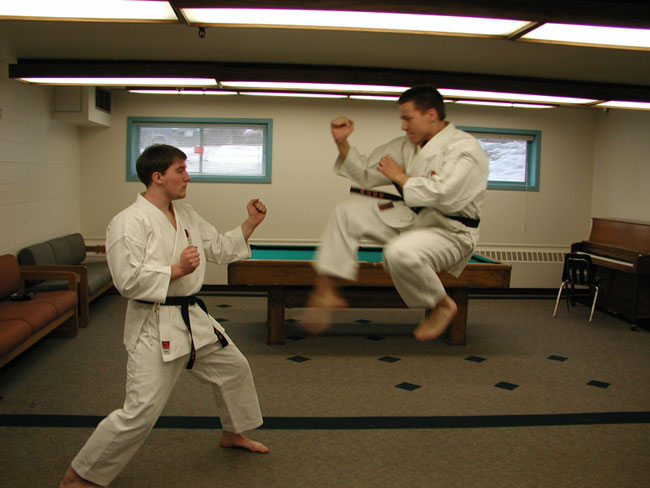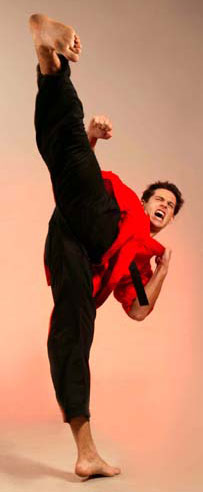![]()
![]()
Many basic physics concepts can be related to the martial arts.
![]()
Newton's First Law of Motion. Every object in a state of uniform motion tends to remain in that state of motion unless an external force is applied to it. This is most evident with nunchaku or the three-section bo (staff). Originally just a stick used to separate grain from the chaff, two sticks were tied together in case one broke. These became nunchaku, a very effective weapon.


Left: Nunchaku. Right: Three-section staff. Images from www.karatedepot.com
Using sectional weapons in combat is very difficult. The swinging portion of the weapon builds up speed, and thusly inertia and kinetic energy. When it strikes something, energy is dissipated into the target. The remaining energy rebounds at an opposing angle. It takes a great deal of skill and experience to control sectional weapons in a combat situation.
![]()
Newton's Second Law of Motion. The force (F) of a strike is equal to the mass (m) multiplied by the acceleration (a). Therefore, the greater the acceleration, the more force a technique has. Note the distinction between acceleration and speed. Karate techniques are taught so as to terminate approximately one inch within the target. This means the attack hits before the slowdown (de-acceleration) begins. In the picture below, I am preparing to deliver a flying front kick. The kick will strike with the force of both my forward momentum and the strength and speed of the attack.

Equation: F=ma. Assume a mass of 77kg and an acceleration of 12 m/s. This works out to 924 Newtons.
![]()

 These images demonstrate yoko-geri kekome, or side thrust kick. The right image is from http://www.matthewmullins.com.
These images demonstrate yoko-geri kekome, or side thrust kick. The right image is from http://www.matthewmullins.com.
The kinetic energy (KE) of a technique is directly related to the velocity (v). Since the velocity is squared, if the speed of a technique is doubled, the KE increases by a factor of four instead of two.
Technique |
Peak Speed (meters/second) |
|---|---|
| Forward Punch | 5.7-9.8 |
| Hammer-fist strike | 10-14 |
| Downward Knife-hand strike | 10-14 |
| Roundhouse Kick | 9.5-11 |
| Wheel Kick | 7.3-10 |
| Front Snap Kick | 9.9-14.4 |
| Side Kick | 9.9-14.4 |
The above table is from the article "The Physics of Karate" from the April 1979 issue of Scientific American.
![]()
Tradition says that you draw your power from the Earth. This is not far from the truth. By pushing into the ground with the legs, that energy travels back up the body, out the limb in question, and into the target. A solid ground connection is an important part of making strong techniques and stances. Other descriptions of this idea include foundation and grounding.
![]()
Newton's Third Law of Motion. For every action, there is an equal and opposite reaction. When punching, the punching hand can only strike out as fast and as hard as the opposing draw hand is pulled back. A kick must be pulled back at the same speed at which it extended. This 'snap' effect creates a shockwave that travels through the target. The idea of action and reaction applies to more than just technique: if you punch someone, they will likely punch back.